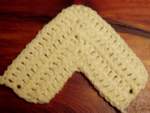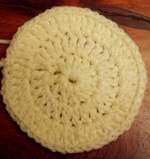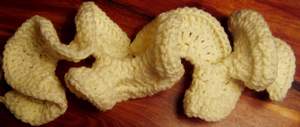|
Crochet Increase
|
Are you stuck on a crochet increase? Have you hit a spot in a pattern where it tells you to increase a certain number of stitches, but you can't figure out how to do it?
Well - I'm here to help! Many times you will increase without even thinking about it. In fact you increase in every row of a granny square when it's worked in the round. Every row contains more stitches as you are increasing at each corner.
You work crochet increases in corners of ponchos, around hats, when you make toy animals, ripple afghans and sometimes in scarves too. Increases are everywhere and you can make all kinds of shapes just by increasing and decreasing.
Usually a pattern will tell you to work several stitches into the same stitch of the previous row. This is increasing the easy way as the designer tells you exactly what to do.
 The 'corner' piture you see here is a good example - at the center of the row I worked 5 double crochets into the same center stitch in each row. If you work less stitches in the same space, your crochet increase 'point' will be shallower and wider, more stitches in the same stitch and your 'point' will be sharper and narrower.
The 'corner' piture you see here is a good example - at the center of the row I worked 5 double crochets into the same center stitch in each row. If you work less stitches in the same space, your crochet increase 'point' will be shallower and wider, more stitches in the same stitch and your 'point' will be sharper and narrower.

If you work only 2 stitches into one stitch of the previous row, you get a more subtle effect. This circle shows how when the number of stitches is doubled in each of 3 rows the circle grows larger and stays flat. If you work no crochet increase, then the circle would end up as a tube.
If you continued to work 2 stitches into each stitch of the previous round, after a few rounds the circle would begin to ripple due to too many stitches.
A good example of working 2 stitches into every stitch is shown in the picture at the top of this page. This is a straight chain, but I worked 2 double crochets into each chain, then the same in each stitch every row for a total of 3 rows. This doubles the stitch count every row - so you can clearly see what happens.
This technique has been used for some scarf patterns. It's easy and effective to use a repetitive crochet increase to form these attractive ripples. If you make a scarf from this method you can either leave it in random ripples or twist it so that it curls around itself like a big spiral.
For a scarf, just chain to the length you want, then work 2 double crochets into each stitch every row until you either run out of yarn, or reach the width you like. Then break your yarn & finish off ends.
Those are the easier ways to crochet increase. The other time you might come across increasing is when making mittens or a sweater, etc. You may work sideways for a rib effect, then the pattern tells you to increase a certain number of stitches evenly across the next row.
You know...that's a pet-hate of mine. When I see that in a pattern it really puts me off, not because I don't like math, but if someone writes a pattern, then I think they should give you ALL of the information you need instead of you having to drag out a calculator.
Anyway - to work out how often you should increase if you find yourself in this situation, this is how I do it...
- Take the number of stitches you have (eg. 30) and divide them by the number of stitches you need to increase (eg. 12). Answer = 30/12 = 2 plus an extra 6. So you know you'll need to crochet increase in every 2nd stitch, BUT...you have 6 leftover stitches. What do you do with them?
- Divide the spare number into 3 (as close as possible), stick one third at the front of the row and the other 2 thirds on the end of the row. Eg. 2/2-2-2-2-2-2-2-2-2-2-2-2-/4. This means that you would work the first 2 stitches, then increase in every 2nd stitch AFTER THAT where the -'s are. This gives you the 12 increases evenly across the row and the spare stitches also are divided equally at either end of the row.
Of course the stitches don't always work out evenly, but if you remember to always put the smaller third (sounds funny I know, but you know what I mean, right?) of the spare stitches at the front of the row, and don't start your crochet increase until the right spot, you'll do just fine!
I think that method is easier than alternating...what I mean is, that you could work the increases every 2nd, then every 3rd stitch, but that might be complicating things further.
So - now that I've probably thoroughly confused you, I think I need to take a nap!
Good luck with your crochet increases - I'm sure you'll manage them just fine with a little practice!





